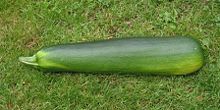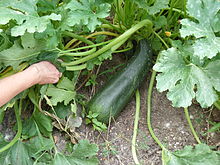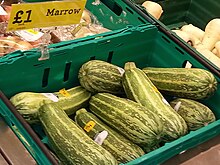 | |
| Type | Fruit |
|---|---|
| Place of origin | England |


A marrow is the mature fruit of certain Cucurbita pepo cultivars used as a vegetable. The immature fruit of the same or similar cultivars is called courgette (in Britain, Iran, Ireland, France, the Netherlands, Singapore, Malaysia and New Zealand) or zucchini (in North America, Japan, Australia, the Czech Republic, Italy, Germany and Austria). Like courgettes, marrows are oblong, green squash, but marrows have a firm rind and a neutral flavour, making them useful as edible casings for mincemeat and other stuffings. They can be stored for several weeks after harvest (like pumpkins and other winter squash), to be processed for food when required. They are a vegetable used in Great Britain and areas with significant British influence, though their popularity is waning in favor of immature summer squash like courgette.
Giant marrows are grown competitively in the United Kingdom, where the term "marrow" is often restricted to the striped, thick-skinned cultivar.
In a culinary context, marrows are a vegetable; usually cooked and presented as a savory dish or accompaniment. Botanically, marrows are fruit, a type of botanical berry, being the swollen ovary of the marrow flower. Marrows, like all squash, have their ancestry in the Americas.
History

According to the Oxford English Dictionary, the first mention of vegetable marrows dates to 1822, zucchini to 1929, and courgettes to 1931. However, the word zucchini had already appeared in newspapers by 1916. Before the introduction of Cucurbita species from the New World, marrow signified the immature, edible fruits of Lagenaria, a cucurbit gourd of African origin widely grown since antiquity for eating when immature and for drying as watertight receptacles when grown to maturity.

Marrows are commonly cultivated in the British Isles, and the term "marrow" for the plant and for the fruit is current there, especially for the striped, thicker-skinned cultivar. However, both in North America (since the 1920s) and in Britain (since the 1960s), thinner-skinned immature marrows have gained popularity due to their tender skin and distinct flavour. Hedrick (1928) in his book The Vegetables of New York, describes the "English Vegetable Marrow" as "one of the earliest forms of marrow squash grown, but has never been exceedingly popular in this country".
The fashion in Britain for eating immature marrows, called "courgettes" in British English, is relatively recent. Sudell (1966) does not mention courgettes, although he has a section on "vegetable marrow", noting both trailing (vining) and bush types and saying "cut when young". Witham Fogg (1966) wrote "Courgettes These are really very tender baby marrows which have long been popular in France. ... Cooked and eaten with butter they form a very palatable dish." He devotes a page and a half to marrows and less than half a page to courgettes, which he clearly regards as something new to Britain.
The heaviest marrow on record weighed 116.4 kg (256 lb 9.8 oz) and was grown by Vincent Sjodin (UK) for entry in the CANNA UK National Giant Vegetables Championships, held at the Three Counties Showground in Malvern, Worcestershire, UK, on 23 September 2021.
Nutrition
Marrows, like zucchini, are low in food energy (approximately 71 kJ or 17 kcal per 100 g fresh marrow) and contain useful amounts of folate (24 μg/100 g), potassium (261 mg/100 g) and provitamin A (200 IU /100 g).
Toxicology
Members of the plant family Cucurbitaceae, which includes zucchini, marrows, pumpkins and cucumbers, can contain toxins called cucurbitacins. These are chemically classified as steroids; they defend the plants from predators, and have a bitter taste to humans. Cultivated cucurbitaceae are bred for low levels of the toxin and are safe to eat. However, ornamental pumpkins can have high levels of cucurbitacins, and such ornamental plants can cross-fertilise edible cucurbitaceae – any such cross-fertilised seeds used by the gardener for growing food in the following season can therefore potentially produce bitter and toxic fruit. Also, dry weather conditions or irregular watering can stress the plant and favour the production of the toxin, which is not destroyed by cooking.
In August 2015, a 79-year-old German man and his wife ate a marrow grown by a neighbour. The couple noted the unusually bitter taste. Shortly afterwards they were both admitted to a Heidenheim hospital, apparently with symptoms of a gastrointestinal infection. The wife, who had eaten a smaller portion, survived, while the husband died. Toxicological analysis of the meal confirmed the presence of cucurbitacin.
In popular culture
"The Marrow Song", also known as "Oh! What a Beauty", was a British song published on 16 December 1952, with words and music by Edrich Siebert. The innuendo-laden song was recorded for Decca by Billy Cotton and his Band with vocals by Alan Breeze and The Bandits on 1 December that year, under the title "The Marrow Song (Oh What a Beauty)". As well as being issued on a single in January 1953, it was included on Cotton's 1955 Saucy Songs EP. In 2013, the recording was featured in a UK television advertisement for the Co-operative supermarket. The song was performed in the 1969 film Kes. This version of The Marrow Song is used at several points in the 2024 video game Thank Goodness You're Here!
Marrows also play an important role in the 2005 animated film Wallace & Gromit: The Curse of the Were-Rabbit. In this film, the character of Gromit is devoted to growing a large marrow. The marrow is eventually destroyed when he uses it to lure the Were-Rabbit. The marrow also appears in the video game based on the film; Gromit can control the marrow's growth by adjusting factors such as soil pH, greenhouse temperature, and water flow, as well as by purchasing fertilizers to increase its size.
Agatha Christie's detective Hercule Poirot often expresses his desire to retire and grow marrows, accomplishing his dream briefly in The Murder of Roger Ackroyd.
References
- ^ Dr. D.G. Hessayon (2009). The Vegetable and Herb Expert. London: Expert Books.
- Slater, Nigel (24 September 2000). "Nigel Slater's marrow recipes". The Guardian. Retrieved 13 October 2015.
- "Marrow". Archived from the original on 2010-03-15.
- Austin, Gareth (23 July 2010). "BBC Dig In blog". Dig In Blog. BBC. Retrieved 11 April 2016.
Courgettes are commonly described as marrows harvested young. However, there are some slight horticultural differences between courgettes and marrows. Courgettes tend to be bushy and thin-skinned , whereas marrows tend to trailing and have a thicker skin.
- "The Gardener's Almanac, entry at "Marrow"". Retrieved 11 April 2016.
The general difference between Marrows and Courgettes/Zuchini is; Marrow plants tend to trail out and the fruit skin is quite thick, whereas Courgettes grow as a bush and the skins are quite thin.
- Sabine, J. (1822). "A description and account of the cultivation of a variety of gourd called vegetable marrow". Trans. Hort. Soc. 2: 255.
- Sunset. 58 (2). 1822.
{{cite journal}}: Missing or empty|title=(help) - Lucas, E. (1931). Vegetable Cookery. 266.
{{cite journal}}: Missing or empty|title=(help) - "A Great Chef's Suggestions". Sioux City Journal. Sioux City, IA. December 26, 1916. p. 3. Retrieved January 15, 2022 – via Newspapers.com.
Then there are the zucchini a sort of green squash.

- Norton, Jeanette Young (August 26, 1917). "Famous Dishes of Italy, Recipes for Which are Given by Notable Italian Cooks". New York Tribune. New York, NY. p. 34. Retrieved January 15, 2022 – via Newspapers.com.
Pare and slice in medium slices six zucchini and fry for a few minutes in olive oil.

- Hedrick, Ulysses (1928). The Vegetables of New York. Vol. 1. Albany: J. B. Lyon company. p. 37.
- Sudell, Richard (1966), Practical Gardening in Pictures, London: Oldhams Books, p. 207, OCLC 220388288
- Witham Fogg, H.G. (1966), Vegetables All the Year Round, London: Stanley Paul, p. 105, OCLC 7404259
- "Heaviest marrow". 23 September 2021.
- Percy Russell & Anita Williams (January 1995). The Nutrition and Health Dictionary. Jones & Bartlett Learning. pp. 473–474. ISBN 9780412989919.
- "Show Foods". September 21, 2015. Archived from the original on 2015-09-21.
- "Poisonous courgette warning". Retrieved 12 October 2015.
- "Auf den Geschmack kommt es an [Taste matters]". 21 August 2015. Retrieved 24 August 2015.
- Zeitung, Süddeutsche. "Mann stirbt an Garten Zucchini [Man dies of garden marrow]". Süddeutsche.de. Retrieved 24 August 2015.
- Catalog of Copyright Entries: Third series. 1953.
- Billy's Your Uncle (back tray). Billy Cotton. Watford, Hertfordshire, England: Vocalion. 2004. CDLK 4237.
{{cite AV media notes}}: CS1 maint: others in cite AV media (notes) (link) - The marrow song Oh, what a beauty, Decca., OCLC 477127481, retrieved 2021-11-15
- Wicks, Don (1998). The Ballad Years, Part 03.
- "Billy Cotton Saucy Songs UK 7" vinyl single (7 inch record) (726211)". eil.com. Retrieved 2021-11-15.
- The Co-operative Food Commercial - Pop Culture Cross-References and Connections on @POPisms, retrieved 2021-11-15
- "Kes (1969) Soundtrack". RingosTrack. Retrieved 2022-08-31.
External links
- "Vegetable Marrow" . Encyclopædia Britannica (11th ed.). 1911.
| Cucurbita | |||||||
|---|---|---|---|---|---|---|---|
| List of gourds and squashes | |||||||
| Species |  | ||||||
| Cultivars |
| ||||||
| Related topics |
| ||||||